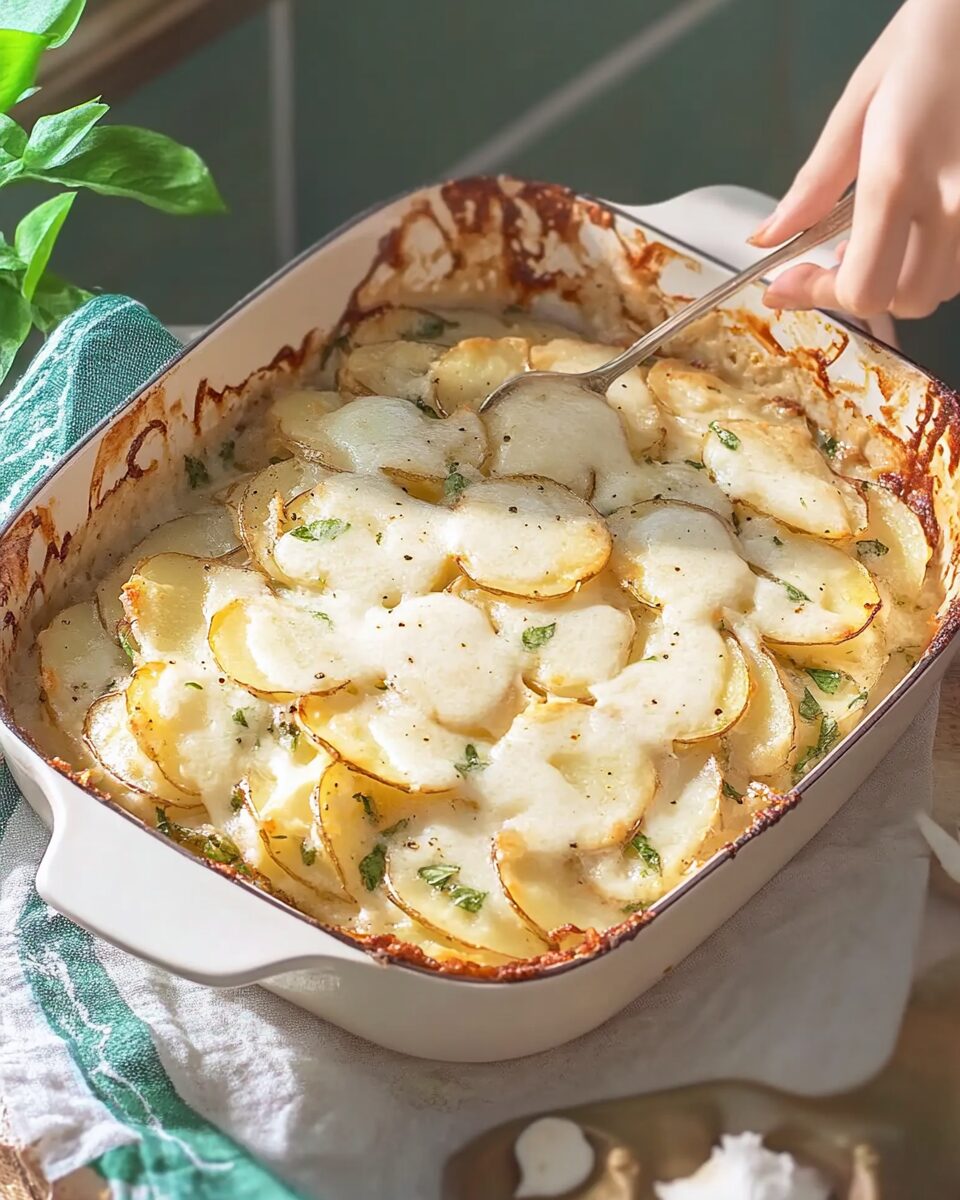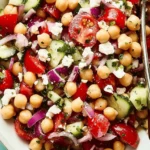Scalloped potatoes are a classic comfort food, featuring thinly sliced potatoes layered and baked in a creamy sauce until tender and golden. This dish pairs wonderfully with baked ham, roast beef, chicken, or pork chops, making it a versatile side for various meals.
FULL RECIPE:
Ingredients
- 4 cups thinly sliced potatoes
- 3 tablespoons butter
- 3 tablespoons all-purpose flour
- 1 ½ cups milk
- 1 teaspoon salt
- ¼ teaspoon freshly ground black pepper
- 1 dash cayenne pepper (optional)
- 1 cup shredded Cheddar cheese
Directions
- Preheat the oven to 350°F (175°C). Grease a 2-quart casserole dish with butter.
- Arrange one-third of the potato slices in an even layer at the bottom of the prepared dish. Season generously with salt, and sparingly with freshly ground black pepper and cayenne pepper, if using.
- Sprinkle one-third of the shredded Cheddar cheese over the seasoned potatoes.
- Repeat the layering process two more times with the remaining potatoes, seasonings, and cheese.
- In a saucepan over medium heat, melt the butter. Stir in the flour and cook for about 1 minute until smooth. Gradually whisk in the milk, continuing to stir until the mixture thickens and becomes bubbly. Season with salt and pepper to taste.
- Pour the sauce evenly over the layered potatoes and cheese in the casserole dish.
- Cover the dish with aluminum foil and bake in the preheated oven for 45 minutes.
- Remove the foil and continue baking for an additional 30 minutes, or until the potatoes are tender and the top is golden brown.
- Allow the dish to rest for a few minutes before serving.
Nutrients Per serving:
- Calories: 250
- Protein: 8g
- Carbohydrates: 30g
- Fat: 11g
- Cholesterol: 33mg
- Sodium: 620mg
- Fiber: 2g
- Sugar: 4g
History and Origins of Scalloped Potatoes
Scalloped potatoes have been a beloved comfort food for generations, with roots tracing back to European cuisine. The term “scalloped” refers to a method of preparing thinly sliced potatoes and baking them in a creamy sauce, usually with butter and milk. While the exact origin is unclear, variations of this dish have been enjoyed in countries like France, England, and the United States for centuries. Some historians believe that the dish evolved from the French gratin dauphinois, which includes potatoes cooked in cream, while others argue that it was an English creation, influenced by the term “collops,” referring to thinly sliced meat or vegetables.
What Makes Scalloped Potatoes Unique?
Unlike mashed or roasted potatoes, scalloped potatoes have a distinctive creamy texture, achieved by baking thin potato slices in a rich sauce. The dish does not traditionally include cheese, differentiating it from au gratin potatoes, which typically have a layer of melted cheese on top. However, many modern variations incorporate cheese, garlic, and other flavorful ingredients to enhance the taste. Scalloped potatoes stand out due to their layering technique, where the slices are arranged neatly in a baking dish, creating a visually appealing and evenly cooked final product. The combination of butter, flour, and milk creates a silky-smooth sauce that infuses the potatoes with rich, savory flavors.
Popular Variations of Scalloped Potatoes
Over time, many cultures and regions have put their own twist on scalloped potatoes, leading to numerous delicious variations. Some of the most popular include:
- Cheesy Scalloped Potatoes: While traditional scalloped potatoes do not include cheese, many people enjoy adding cheddar, parmesan, or gruyère for an extra layer of flavor.
- Garlic and Herb Scalloped Potatoes: This version incorporates minced garlic, rosemary, thyme, or parsley to give the dish a more aromatic and flavorful profile.
- Scalloped Potatoes with Ham: Adding diced ham turns scalloped potatoes into a heartier dish that can be served as a main course rather than a side.
- Vegan or Dairy-Free Scalloped Potatoes: For those who follow a plant-based diet, dairy alternatives like coconut milk, cashew cream, or almond milk can be used to create a creamy consistency without traditional dairy ingredients.
- Spicy Scalloped Potatoes: Adding cayenne pepper, paprika, or jalapeños gives the dish a bit of heat, making it a more exciting side for spicy food lovers.
Best Potatoes to Use for Scalloped Potatoes
The type of potatoes you choose can make a big difference in the final texture of the dish. Some of the best options include:
- Russet Potatoes: These potatoes have a high starch content, which helps create a creamier, softer texture. However, they tend to break apart more easily.
- Yukon Gold Potatoes: Known for their buttery flavor and firm texture, Yukon Golds hold their shape well while still providing a smooth consistency.
- Red Potatoes: These potatoes have a waxy texture and hold their shape well but may not be as creamy as russets or Yukon Golds.
How to Achieve the Perfect Creamy Consistency
One of the key factors in making perfect scalloped potatoes is achieving the right consistency in the sauce. Here are some essential tips:
- Use a Roux: A roux (a mixture of butter and flour) helps thicken the sauce and prevents it from being too watery.
- Warm the Milk: Adding warm milk to the roux prevents lumps from forming and ensures a smooth, velvety texture.
- Slice the Potatoes Evenly: Using a mandoline slicer ensures that all the potato slices are uniform, which helps them cook evenly.
- Do Not Overcook: While scalloped potatoes should be tender, overcooking can cause them to turn mushy. Check for doneness by inserting a fork; the potatoes should be soft but still hold their shape.
Pairing Scalloped Potatoes with Other Dishes
Scalloped potatoes are a versatile side dish that pairs well with various proteins and vegetables. Some great pairings include:
- Baked Ham: This is a classic combination, often served during Easter or holiday dinners. The creamy potatoes complement the salty, smoky flavors of ham.
- Roast Chicken: The mild flavor of roast chicken balances the richness of the potatoes, making for a well-rounded meal.
- Grilled Steak: The creaminess of scalloped potatoes pairs wonderfully with the bold, savory flavors of a perfectly grilled steak.
- Vegetarian Dishes: For a meatless meal, serve scalloped potatoes with sautéed mushrooms, roasted Brussels sprouts, or a fresh green salad.
Storing and Reheating Scalloped Potatoes
If you have leftovers, scalloped potatoes can be stored and reheated easily. Here’s how:
- Refrigeration: Store leftovers in an airtight container in the refrigerator for up to 4 days.
- Freezing: Scalloped potatoes can be frozen, but the texture may slightly change. To freeze, let the dish cool completely, then wrap it tightly in plastic wrap and aluminum foil before placing it in the freezer for up to 3 months.
- Reheating: To reheat, place the potatoes in an oven-safe dish, cover with foil, and bake at 350°F (175°C) for 20-30 minutes. If reheating from frozen, allow them to thaw overnight in the refrigerator before baking.
Health Benefits of Scalloped Potatoes
While scalloped potatoes are known for their creamy, indulgent nature, they also offer some nutritional benefits:
- Good Source of Potassium: Potatoes are naturally rich in potassium, which supports heart health and proper muscle function.
- Vitamin C: Potatoes contain vitamin C, which helps boost the immune system and promotes healthy skin.
- Dietary Fiber: Depending on the type of potato used, scalloped potatoes can provide fiber, which aids digestion.
Conclusion
Scalloped potatoes are a timeless, comforting dish that has been enjoyed for generations. Their rich, creamy texture and versatile nature make them a favorite side for holiday gatherings, family dinners, and special occasions. With endless variations and the ability to pair well with many main courses, they remain a staple in kitchens worldwide. Whether you stick to the classic recipe or put your own twist on it, scalloped potatoes are sure to be a crowd-pleaser.






